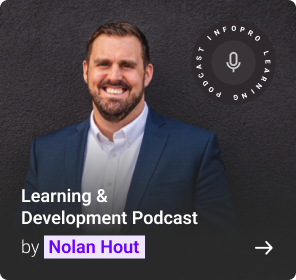In employee learning & development, it’s crucial to use various learning strategies for on-the-job training, as different individuals have different ways of comprehending the information. These strategies accommodate diverse learning styles, ensuring the training materials are as effective as the learning methods. A learning strategy is a planned approach learners use to apprehend the training material, solve workplace challenges, and get things done efficiently and effectively.
The learning strategy for training equips individuals with the expertise to design and implement impactful learning solutions. This includes knowledge of instructional design, needs assessment, content development, learning methodologies, and evaluation techniques. Understanding these aspects helps professionals develop targeted, strategic, and result-oriented learning programs.
What Shapes an Effective Learning and Development Strategy?
Two primary influences make a firm basis for creating a winning L&D strategy:
Strategic Goals or Business Direction
The L&D strategy must be aligned with the company’s direction and goals while also considering internal and external factors (like market trends and past performances). Improving products, enhancing business models, increasing R&D efforts, expanding deployment, or addressing skill gaps that guide the strategy are a few changes that can be made. These changes can apply to the whole company or only a few teams. To remain aligned, employee development and reskilling programs should mirror the company’s goals to ensure the right levels of investment and engagement are brought to the table.
Existing Operational Factors
Operational aspects such as workplace culture and existing learning management systems significantly influence L&D plans. Everything from leadership expectations, budgets, timelines, existing learning technology, and outsourcing requirements to employees’ willingness to learn must be considered. Learning about these will help learning leaders adjust their strategy to whatever is already happening and ensure that it flows seamlessly into their workflows.
Building a 2025 Learning Strategy: Key Insights and Action Items
As the new year approaches, organizations must formulate a 2025 learning strategy beyond supporting today’s business objectives. It must also equip employees with the skills and knowledge necessary to prosper in the evolving workplace. Listed below are a few learning strategies that L&D leaders can invest in:
1. Understand the 2025 Business Landscape and Objectives
A good L&D strategy starts with a strategic understanding of your company’s long-term goals. By 2025, businesses may pursue global expansion, digital transformation, product innovation, or market diversification. L&D leaders should adapt learning initiatives to align with these objectives and equip the workforce for future challenges.
Action Item:
Start with senior executives and department heads to understand the organization’s strategic plan, such as growth targets, innovation imperatives, and market expansion. Perform a needs analysis to determine areas requiring rigorous L&D support. Secondly, if the customer experience is the major goal, establish the skills required for customer empathy, communication and problem-solving as a part of your employee learning strategy.
2. Implement a Learning Management System (LMS)
A learning management system is essential for a large-scale employee learning strategy. These strategies typically include customizing resources based on individual needs, monitoring progress, and fulfilling knowledge gaps through targeted interventions. LMS can be used to deliver customized training programs to align learning initiatives with the needs of individual employees. An LMS provides superior training accessibility, engagement, and effectiveness by giving access to the resources prescribed per a learner’s need across various training formats.
Action Item:
Conduct a needs assessment and choose an LMS. Create a task force to manage how the system integrates and how to train employees to work on the platform. Regularly evaluate the strengths and weaknesses of the LMS so it continues to fulfill your changing learning needs.
3. Focus on Future Skills
To keep your workforce at the top of its game in an ever-evolving environment, you need to pinpoint important skills that will increasingly be in demand, such as digital literacy, data analytics, emotional intelligence, and agile leadership. To prepare for the future, today’s L&D programs can and should focus on developing the future-focused competencies of their current workforce.
Action Item:
Perform a detailed skills gap analysis to identify gaps in technical skills (e.g., data science, AI, coding) and human skills (e.g., adaptability, collaboration, critical thinking). Map this assessment to the organization’s 2025 goals to ensure future fit. In addition, create and execute learning pathways that address these gaps, providing foundational instruction for newcomers and advanced modules for expert proficiency. Doing so ensures their employees are accustomed to their future jobs and responsibilities.
4. Build User-Centered Learning Spaces
Learning leaders should not forget the ‘people-first’ approach while devising a learning strategy. It is no longer just about the content or the program but should be centered around the learners. L&D professionals can create more productive learning pathways by assessing what employees want and need. The flexibility given to employees in completing training modules based on their schedules and interests increases the odds of successful results compared to rigid and mindless training modules. Identifying key learning content elements makes them more relatable and interesting to the participants. In addition, continuous improvement of training materials and training programs is important. In a digital world where tech and content can become stale overnight, up-to-date, valuable training resources drive engagement and effectiveness.
Action Item:
To facilitate continuous engagement, provide training resources via multi-device applications. Access across phones, laptops, or tablets allows employees to complete training conveniently. This means that employees are far more likely to complete their training because they can consume the content from almost anywhere.
5. Leverage Data and Technology
L&D leaders must integrate data and technology into their initiatives to align the learning strategy with 2025 business objectives. Learning management systems, analytics platforms, and AI-driven tools offer valuable insights into learner progress, skill gaps, and the overall effectiveness of training programs.
Action Item:
Optimize learning strategies by using data analytics to track metrics like engagement and outcomes, refining programs as needed. Leverage AI for personalized learning paths tailored to roles and goals and boost engagement with gamification elements like leaderboards and badges.
6. Integrate Learning with Leadership Development
Leaders need leadership skills to be effective in their organizations in 2025 and beyond, with emotional intelligence, improved decision-making skills, resilience, and facilitating inclusivity in leading cross-functional reps being some of the key focus areas. Leadership development initiatives should empower both current and emerging leaders.
Action Item:
Establish leadership programs within the organizational ecosystem to train individuals in essential leadership skills. Incorporate mentoring, coaching, and managing cross-functional projects to prepare them as future leaders. At the same time, a solid leadership pipeline needs to be built by spotting high-potential employees and putting them on fast-track development paths. Such an approach prepares the next professional contingent with the skillsets necessary to traverse business complexities and help catalyze the organization’s movement toward its 2025 goals.
Conclusion
In 2025, learning and development strategies must look further ahead than immediate needs. Scheduling a course of action for all employees is the most successful measure, so their attitudes and performances are combined to adapt to the changing environment. Tech-based tools like LMS and AI-based analytics facilitate personalized, outcome-based pedagogy. They build a strong pipeline of leaders with resilience, strategic thinking, and cross-function management capabilities. Investment in people leads to sustainable success, and the foundation of this success is a flexible and future-ready L&D framework.





